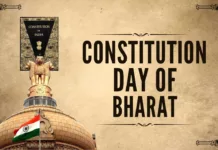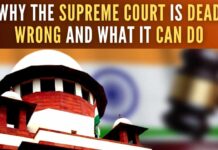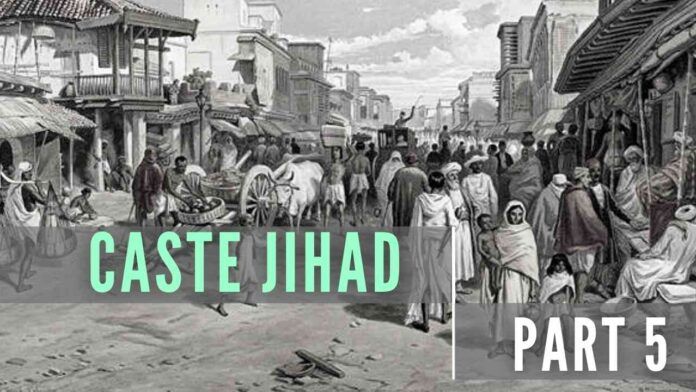
The previous 4 parts of the article can be accessed here Part 1, Part 2, Part 3, Part 4. This is the fifth part
-
All Religions have Castes
-
No Widespread Discrimination against SC/ST
Neither there is any truth that only Hindus have the castes nor there is a place for the so-called caste system in India, South Asia, and/ or the U.S. in the modern age. Yet, the founder and associates of the highly controversial and self-serving Equality Labs (EL)[1], with many inherent “inequalities” in its own mission and activities, continue to spread caste jihad in the United States by using the phrases like “upper-caste” and “lower-caste” Hindus as if the caste exist only among Hindus[2]. That is a total “myth” and a topic of this article based on a recent survey by the Pew Research Center (PRC), published[3].
One cannot deny that the Dalits (minimally used term in India now) were discriminated by other castes and some of it still continues but the “caste-based” discrimination against Dalits in the U.S. is unfounded. In fact, the PRC survey results show that there is no widespread discrimination against the SC and ST which include Dalits. However, a handful of activists continue a false campaign of caste-based discrimination in the U.S. for personal gains and notoriety. As discussed in part 4, India’s constitution, crafted by the great scholar Ambedkar, a Dalit himself, does not use the term upper, lower, and/ or Dalit as the identifiers. It categorizes people as SC, ST, OBC, and EWC who are protected under India’s reservation/ quota system (which should be abolished or at least reformed) and the remainder as General Category (GC).
The PRC Report:
It is based on a survey of about 30,000 people from all religions in India with a proportionate representation identifying different religions (shown in the graphic). The survey was done in various regions of India, in many different languages, across all age groups, and both genders. Thus, the report is based on very scientific, comprehensive, well-executed, and systematically analyzed data. The complete graphic can be seen in the report.

Religions and Castes:
It is important to briefly dive into the history of various religions of India. The ancient history of Bharat is rooted in Sanatan Dharma with the word Hindu referring to the land of the people who lived across the River Indus. Bharat was popularly called Hindustan by the 13th century meaning the “land of Hindus.” Fast forwarding, the Muslim invaders forcibly converted millions of Hindus to Islam and later the Christians Missionaries converted Hindus to Christianity in an effort to divide and rule and break the bone of India’s strong Dharmic values. Consequently, the Muslims and Christians in India, essentially the born Hindus, carried the “caste” label even after the conversion. Thus, it is fair to assume that much of South Asia have Muslims and Christians of Hindu descent.[4]
India’s other religion, Sikhism, is of relatively recent origin founded by Guru Nanak who did not believe in Hindu rituals and idolatry and did not like casteism during his time. Buddhism, another offshoot of Hinduism, is rooted in the concept of salvation which, over time, attracted a large number of SCs including Dalits of India when their spiritual leader Ambedkar adopted Buddhism.
The Castes in India:
The truncated Table below shows surveyed people of all religious identify in various caste-classification as stipulated in India’s constitution. While the percentages vary, it is undisputed that all religions have caste-related fault lines – the SC, ST, and OBCs currently protected under the reservation/ quota system. This implies that the much-hyped caste-based discrimination in the U.S., if any, is not only in and by the Hindu community. Regrettably, the EL has been tarnishing India’s image, especially Hindus, with a false narrative in the media, higher education, and the tech industry as if only Hindus have the caste system and the GCs engage in discrimination against the SCs which de facto include Dalits.[4]
What surprised?
The biggest surprise for me is that the Christians and Sikhs have a significantly large percentage of SCs than Hindus. I understood that all male Sikhs are Singh and female are Kaur and they don’t have castes. I am not as surprised about 89% of Buddhists being SCs because of the mass migration of Dalits after Ambedkar himself did it. I was not aware that Jains have such a large number of GCs and the negligible number of SC/ STs. The fact that about 70% of the survey subjects identified themselves as SC, ST, and OBC will further validate the discussion below that there is no widespread discrimination against them.
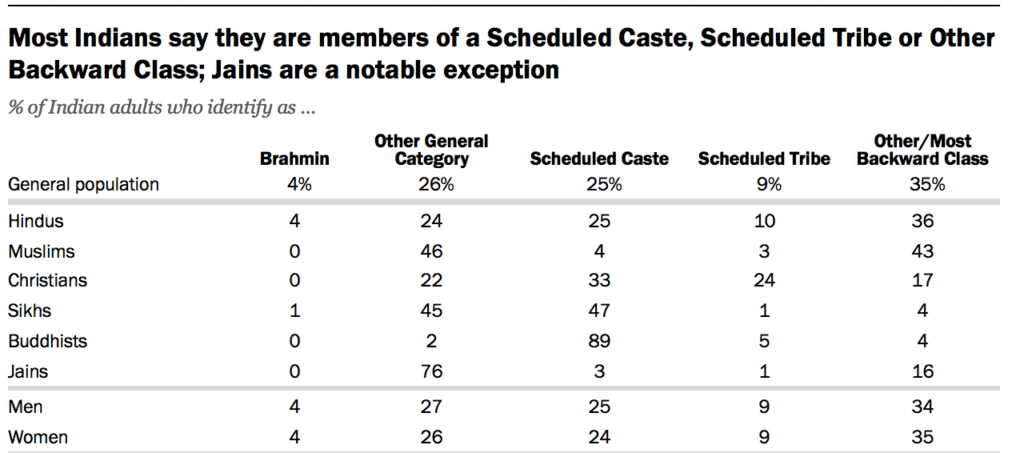
Caste-based Discrimination in India:
I am happily surprised that most Indians did not perceive widespread caste-based discrimination although it varied by region[4]. The Table shows that Indian Christians have the highest percentage of discrimination (~30%) against SC and ST. The good news is that only about 20% of the general population perceive widespread discrimination against SC and ST. In fact, the SC and ST themselves perceive it to be only 26% and 23% (see the line just above the last in the Table). It should also be noted that Brahmins are perceived to have slightly lower percentage (17%) than all other GCs (19%) to be engaged in widespread discrimination.
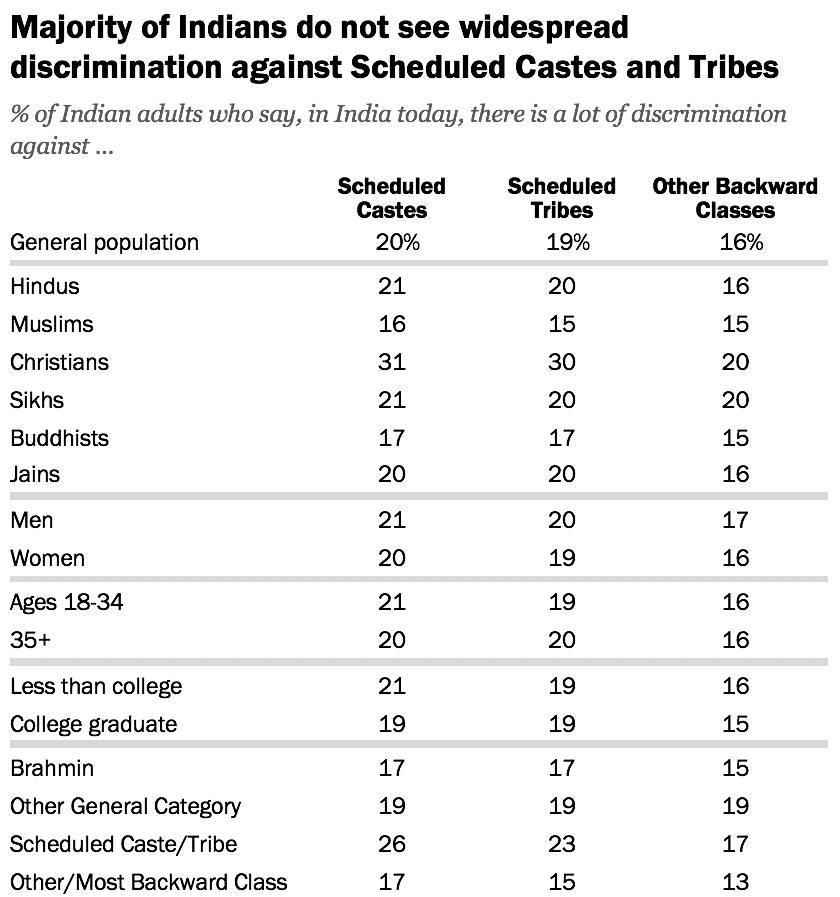
The Big Question?
We know that all religions include people of different castes and there is some caste-based discrimination in India even though it is unlawful. The United States is no different in that discrimination in various forms is present in most places which is unlawful. The big question is that if the discrimination is not as widespread in India, are Indians with different religious and caste associations discriminate more against the SCs (which includes Dalits) after they get to the United States? The next article will focus on discrediting the widespread EL’s caste-jihad through a comparison of PRC findings with EL’s highly unscientific data from a 2018 survey. We will attempt to demystify the myths perpetrated by EL.
To be continued…
Note:
1. Text in Blue points to additional data on the topic.
2. The views expressed here are those of the author and do not necessarily represent or reflect the views of PGurus.
References:
[1] BUSTING THE LIES OF EQUALITY LABS – Unravelling The Truth
[2] Inequalities in the mission of Equality Labs – Jun 09, 2021, PGurus.com
[3] RELIGION IN INDIA: TOLERANCE AND SEGREGATION – Who We Surveyed in India – Jun 29, 2021, Pew Research Center
[4] RELIGION IN INDIA: TOLERANCE AND SEGREGATION – 4. Attitudes about caste – Jun 29, 2021, Pew Research Center
PGurus is now on Telegram. Click here to join our channel and stay updated with all the latest news and views
For all the latest updates, download PGurus App.
- Education and election in Bharat: Race to the top - April 16, 2024
- Kejriwal: “An Insignificant Man” or a corrupt politician with impending prison term - March 24, 2024
- Bharat’s general elections and the Model Code of Conduct - March 22, 2024


